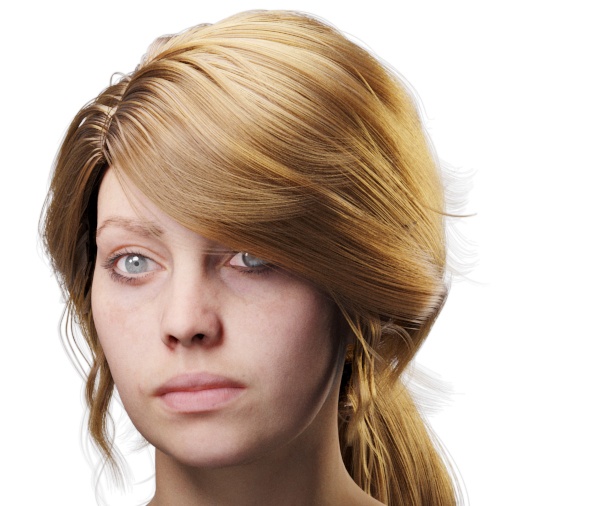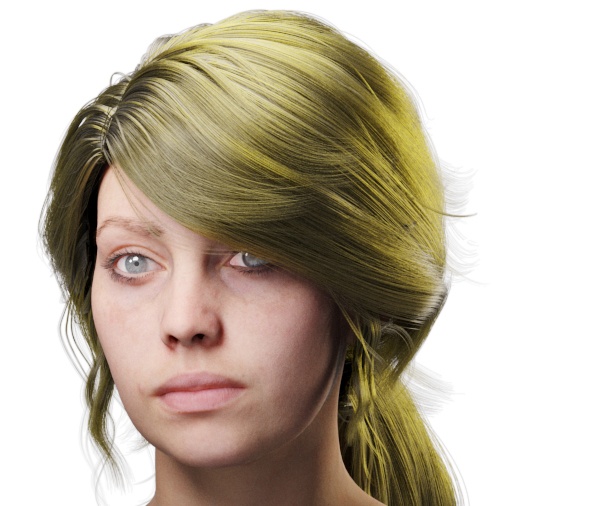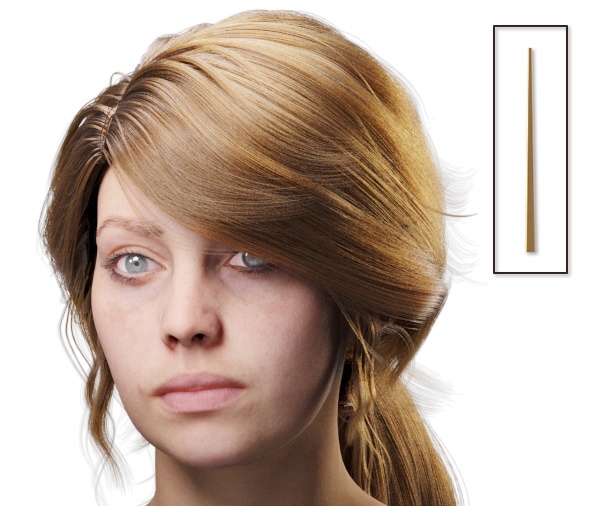This page provides information on the BRDFHair4 material node.
Overview
The V-Ray Hair material is specifically designed for rendering hair and fur and provides settings for a workflow based on the physiology of real hair. Instead of tweaking arbitrary colors that mix together, the new V-Ray Hair material uses a simple melanin slider that determines the hair color just like in the real world. The material is the product of research based on the paper A Practical and Controllable Hair and Fur Model for Production Path Tracing.
Main
Melanin – The pigmentation component that gives the hair strand its main color. The higher the value assigned, the higher the concentration of melanin and the darker the hair strands are. See the Melanin example below to understand how different values work.
Pheomelanin – The redness (pheomelanin content) of the hair strand as fraction of all melanin. 1.0 makes the hair redder. The ratio of melanin to pheomelanin determines how red the hair is. The pheomelanin amount has no effect if the melanin is set to 0. See the Pheomelanin example below.
Dye Color – Applies a color tint to the hair. For a dyed hair look, set the melanin to 0, otherwise the melanin darkens the dye color and pheomelanin introduces redness to it. White means no hair dye. See the Dye color example below.
Transparency – Controls the transparency of the hair. White is fully opaque, while black is fully transparent.
Diffuse – Controls the diffuse component of the shader. Use this for materials made out of cloth threads or other non-translucent fibers, as well as for dirty hair. Note that clean hair or fur does not normally have a diffuse component, so if you want to disable it, leave the Diffuse Amount at 0.
Diffuse Amount – Specifies the amount for the diffuse component of the material.
Glossiness – Controls the glossiness along the hair strand. It primarily controls the width of the highlight, essentially how shiny the hair appears.
Glossiness Boost – Additional scaling factor to boost the primary reflection glossiness. This can be useful for reproducing the effect of shiny coating on rough looking fur.
Softness – Controls the overall softness of the hair by how much the highlights are wrapped around the individual hair strands. Higher values make the highlights wrap almost completely around the strands giving the hair a smoother look, while lower values make it look crispier. See the Softness example below.
Highlight Shift– Shifts the highlights along the hair strand. Positive values shift the highlight away from the root of the hair, while negative values move the highlight closer to the root. Values in the range 2-4 are typical for human hair. See the Highlight shift example below.
IOR – Hair index of refraction. The typical value for human hair is 1.55. The higher the value, the more reflective the hair strands. See the IOR example below.
Trace Depth – The number of indirect bounces used to compute the effect of the multiple scattering. It can significantly affect the hair appearance, especially for light colored hairs. The number of bounces necessary can vary from 5 for dark colored hairs, to 30 and more for light colored ones.
Compensate Energy – When enabled, compensates for a lack of light bounces in areas where the hair is denser and light cannot pass sufficiently.
Example: Melanin
The pigmentation component that gives the hair strand its main color. The higher the value assigned, the higher the concentration of melanin, the darker the hair strands are. In the example below, pheomelanin is set to 0.
Example: Pheomelanin
The redness (pheomelanin content) of the hair strand as fraction of all melanin. 1.0 makes the hair redder. The ratio of melanin to pheomelanin determines how red your hair is. The pheomelanin amount has no effect if melanin is set to 0. In the example below, melanin is set to 0.4.
Example: Dye color
Applies a color tint to the hair. For a dyed hair look, set the melanin to 0, otherwise the melanin darkens the dye color and pheomelanin introduces redness to it. White means no hair dye. In the example below, the Dye Color is set to pink (H=0,S=250,V=104) and we the hue value is adjusted. Melanin is set to 0.4.
Example: Softness
Controls the overall softness of the hair by how much the highlights are wrapped around the individual hair strands. Higher values make the highlights wrap almost completely around the strands giving the hair a smoother look, while lower values make it look crispier. In the example below, the effect is also shown on a single hair strand. Melanin is set to 0.4.
Example: Highlight shift
Shifts the highlights along the hair strand. Positive values shift the highlight away from the root of the hair, while negative values move the highlight closer to the root. In the example below, melanin is set to 0.6.
Example: IOR
Hair index of refraction. The typical value for human hair is 1.55. The higher the value, the more reflective the hair strands. In the example below, melanin is set to 0.6.
Glint
The Glint rollout provides control over the Glint (focused highlight) and the Glitter (focused colorless highlight) parameters.
Strength – Controls the strength of the colored highlights across and along the strand.
Variation – Adds a random glint variation along the strand. It affects the glint strength and orientation; the original secondary highlight strength and orientation; the softness, glossiness and highlight shift.
Glitter Strength – Controls the glitter strength. Glitter is the additional more focused colorless highlight, which is randomly scattered along the strand. It is more pronounced with hard lighting produced by small or collimated light sources.
Glitter Size – Controls the size of the randomization pattern applied. Increasing the value increases the size of the pattern.
Scale – Internally, the variation along the strand is set in real world units. This parameter allows correction of the appearance of hair not modeled in real world scale. Values below 1.0 shrink the variation pattern, while values above 1.0 elongate it.
Example: Glint Strength
Controls the strength of the highlights along and across the hair strand. All other parameters are set to their default values.
Example: Glint Variation
The Glint Variation randomizes the glint effect along the strand. All other parameters are set to their default values.
Example: Glitter Size
The Glitter Size controls the size of the randomization pattern applied. The higher the value, the more variation. All other parameters are set to their default values.
Example: Glitter Strength
Controls the strength of the glitter highlights. The higher the value, the more pronounced the effect. All other parameters are set to their default values.
Tint
Primary – The color tint for the primary component. Corresponds to the light reflected off of the outer surface of a hair strand.
Secondary – The color tint for the secondary component. Corresponds to the light piercing through and reflecting off of the back surface of a hair strand.
Transmission – The color tint for the transmission component. Corresponds to the light going through the hair strands.
Example: Primary Tint
The color tint for the primary component. Corresponds to the light reflected off of the outer surface of a hair strand. In the example below the Primary tint color is set to pink (H=0,S=172,V=132) and we adjust the hue value and the melanin to 0.6.
Random
The Randomization parameters can be used to introduce variation of the general parameter values. When using randomization, different hair strands receive slightly different values for the below parameters, so in fact the randomization works on a per strand basis.
Melanin – Adds variation to the amount of melanin in each hair strand.
Dye Hue – Adds variation to the hue component of the dye color. This makes each strand appear with a different dye color. This parameter has no effect, when the dye color is not used, i.e. when the dye color is pure white.
Dye Saturation – Randomizes the saturation of the dye color between hair strands. This makes each strand appear with a more or less saturated dye color. This parameter has no effect, when the dye color is not used, i.e. when the dye color is pure white.
Dye Value – Adds variation to the value component of the dye color. This makes each strand appear with a brighter or darker dye color. This parameter has no effect, when the dye color is not used, i.e. when the dye color is pure white.
Gray Hair Density – Adds variation to the number of gray hair strands. You can also assign a texture map to this parameter to specify areas where the density is higher.
Glossiness – Randomizes the glossiness of each hair strand.
Softness – Assigns a random value for the softness parameter for each strand. This makes some hair strands appear crispier, while other appear softer.
Highlight Shift – Adds variation to the highlight shift for each strand. This offsets the highlights closer or further away from the root of the hair on a per strand basis.
IOR – Randomizes the IOR value for each hair strand. This makes some strands more reflective, and others - less reflective.
Tangent – Adds a random offset to the hair tangent. This makes the hair stands receive light from slightly different directions, which also means that the highlights are placed in slightly different places for each strand. Note that this parameter is depends on the scene scale.
















































































































